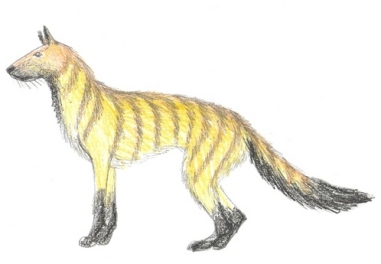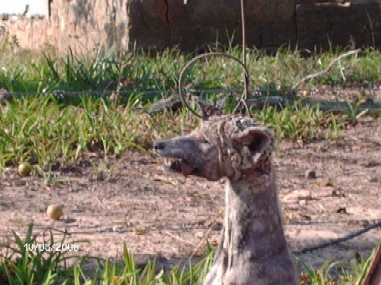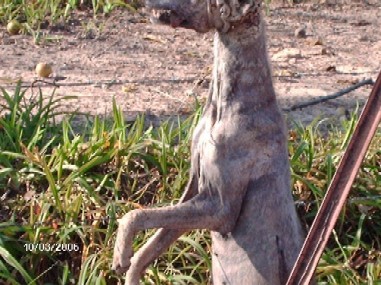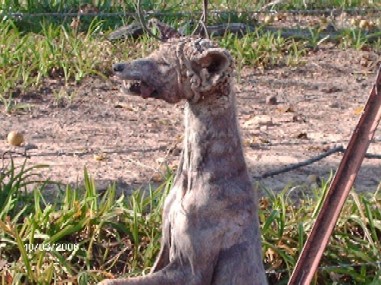Ozark Mystery What-Is-It?
Posted by: Loren Coleman on November 16th, 2006
What do you think?
A man was out squirrel hunting in the Ozarks; he killed a squirrel and out of the woods rushed an animal trying to grab the squirrel. So the hunter shot that thing too. Hard to believe? Here are the photographs of the thing, which some people feel has some banding on the body.
As you can see from the dates on the images, the photographs are from October 2006. The location is Ozark, Arkansas, west of Russellville about 45 miles. A similar animal was spotted around Hector. Hector is a tiny hamlet in the Ozark Mountains just about 20 miles north and slightly east of Russellville.
By strange coincidence, the person who forwarded the photographs to our informant is the niece of local fiction writer Charles Gramlich, who wrote a 2002 novel, Cold in the Light, about some bizarre creatures set in the Ozark Mountains. The book is partially based on some of the real background of the area, of course.
The local game warden, known only by the name Ben, went out to check on this animal, and he thought it was a coy-dog, a cross between a dog and a coyote. He said it had dog feet and a coyote mouth. It was "completely eat up with the mange."
The warden added the detail that this thing is the same color of the supposedly "Ozark monster." Nothing else was mentioned about "what" Ozark monster. But see the drawing at the end of this posting, following the photos.
Click on image for full-size version
Click on image for full-size version
Click on image for full-size version
Click on image for full-size version

What is this Ozark Mystery? Is it nothing but another diseased-canid-as-cryptid incident?
Meanwhile, if that wasn’t intriguing enough, how about the following drawing of another creature seen but not identified in middle America?

Thanks to Cryptomundo correspondent Kelly Freeman.
About Loren Coleman
Loren Coleman is one of the world’s leading cryptozoologists, some say “the” leading living cryptozoologist. Certainly, he is acknowledged as the current living American researcher and writer who has most popularized cryptozoology in the late 20th and early 21st centuries.
Starting his fieldwork and investigations in 1960, after traveling and trekking extensively in pursuit of cryptozoological mysteries, Coleman began writing to share his experiences in 1969. An honorary member of Ivan T. Sanderson’s Society for the Investigation of the Unexplained in the 1970s, Coleman has been bestowed with similar honorary memberships of the North Idaho College Cryptozoology Club in 1983, and in subsequent years, that of the British Columbia Scientific Cryptozoology Club, CryptoSafari International, and other international organizations. He was also a Life Member and Benefactor of the International Society of Cryptozoology (now-defunct).
Loren Coleman’s daily blog, as a member of the Cryptomundo Team, served as an ongoing avenue of communication for the ever-growing body of cryptozoo news from 2005 through 2013. He returned as an infrequent contributor beginning Halloween week of 2015.
Coleman is the founder in 2003, and current director of the International Cryptozoology Museum in Portland, Maine.














It looks almost like a very, VERY large meerkat. Probably just a diseased fox, though, or maybe an escaped hunting dog turned feral and acting upon its former training.
Looks like a mangy coyote.
Speaking of the Ozarks: Loren, are you sure that the “Ozark Howler” was fabricated by one hoaxster? You mentioned this before, but there seems to be several sets of accounts of some kind of strange canid, felid, or hyenid(?) collected by a couple different sources. Are you sure this was all a hoax?
poor thing. If the jaw was slightly different and there was less hair than it already almost doesn’t have, I’d say it was the elmandorf beast, but it just looks like a sick canine of some sort. The drawing at the bottom looks interesting, though.
What exactly was the point of stringing the carcass up in that fashion?
To pose the animal in some way to make it appear something more sinister than it might really be?
Just asking.
It may be a diseased fox, but foxes are a little bit larger than this thing and may be it is a cross between to different animals, but I think this one is a new kind of canid and also there is some similarity to me with the so called “Chupacabras” don’t you think?
Denuded of fur, the necks of canids do look surprisingly long.
The drawing presented looks strangely aardwolf-like.
It’s very very hard, isn’t it? So many animals look similar. Add the factor of missing hair, and who knows? I mean really – who of us is actually qualified to make best guesses as to the identity of a hairless version of an otherwise fur-covered animal? From still photographs of dead specimens strung up into peculiar contortions, no less?
I think I’ll just say I have no idea and leave it at that! 😀
Chris.
Coyote, not fox. With mange. The size, and the color give it away. It’s too large to be a fox and a fox would have black legs. A fox also has a more gracile body shape. It could be a coy-dog but I’d bet on plain old coyote. The “banding” is just the normal coloration of the skin. Looks like a young, possibly pregnant, female. That would explain its ravenous hunger.
That is a coyote with health problems, looks like mange. The ear size, shape and position are the dead give aways. I deal with these little guys frequently and they are very fast learners. It would not surprise me that this one had learned to steal animals that had already been shot. Just like ravens that fly toward the sound of a gunshot in hopes to eat some of the leftovers once the hunters have cleaned their kill.
I will post the details on the Ozark Howler in a separate blog. But for now, let me say, “different sources” and “several sets of cases” were completely fabricated mainly by one individual.
Why is it that all the canid mystery animals of late, (except the one in Maine) suffer from mange? Is it possible that a new genetic strain has mutated into play in the union between coyotes and dogs? Isn’t mange caused by some type of mite? Perhaps we have some kind of micro-cryptid, a new breed of mite that can strip an animal of fur. Who knows, just an idea.
I vote sick Coyote. Placement of the ears and jaw lead me to this conclusion. Some of you guys say this is too big for a fox. I have seen WAY bigger foxes.
Another point is that there are a lot of foxes and coyotes/ coy-dogs that have skin conditions/mange that are floating around. Many of them live on for years, (depending on location/climate) and act just as ones that do not display these symptoms. Western NY has a pretty big number of foxes that exhibit some of these problems. It almost seems that the frequency that they are turning up is increasing. Perhaps pollution is a more predominate factor in some areas than it used to be.
You can see a close-up of the poor critter’s head here.
I seriously can’t even make a guess on what this is, all I know, is it is totally disgusting. Ick.
On the Kentucky Bigfoot site there’s mention of a hyena-like animal being seen. Here’s a link to the story.
I don’t know for sure what that animal is, but my guess is that it’s somekind of mangy coyote or dog. Who knows if somebody didn’t shave the snout of the animal and hung it by the neck to make it appear extended.
Might be a hoax. DNA testing is the only way to know for sure.
Coyote or fox – No sense starting an “Ozark Mutant” media frenzy about it. Many animals, including Foxes, Coyote, and even Grizzly Bear have learned to view gun fire as a dinner bell, this animal was probably ill and desperate and ignored it’s usual “caution” instinct. (That’s If the fur wasn’t removed by the person who shot it!)
Yep, definately another sick puppy. Must be a bumper crop of mites this year.
hey loren very interesting article about this ozark cryptid . i realy like the photos as well. bill
I lived in the Ozarks for a period during the mid-90s and did my share of hunting there. I’d say the critter in that photo is more than likely a mangy coyote.
busterggi Says:
“Must be a bumper crop of mites this year.”
Actually mange is very common and sooner or later it affects almost all young canids born in the wild. Usually the animal eventually overcomes the mite infestation, and becomes pretty resistant to future infestations. Sometimes, if an animal’s immune system is compromised in some way by illness, infection, or some other condition, the mange infestation can become overwhelming and the animal may die from some secondary problem such as a skin infection that leads to septicemia, or from exposure due to the lack of fur. But even animals as severly affected as this one usually survive and eventually regrow their coat.
Most people don’t realize how common and widespread mange is. It affects dogs, squirrels, skunks, cattle, goats… just about all mammals can be affected by sarcoptic mange, even humans (it’s called scabies when humans get it). Cats rarely get mange because in the course of their intensive grooming, their rough tongues remove most of the mites before they have a chance to burrow into the skin.
The closet that most people ever come to wild or even to feral canids is the Animal Planet, so of course a mangy coyote or fox looks weird to them. But it is a common affliction, especially of puppies.
I feel sorry for this Animal. That was one poor sick unhappy beast. At least now I hope it knows peace.
If people wanted to know that much its origin, was a DNA sample taken?
Myself, I as yet see nothing Cryptid here.
1.Fox
2.mainge
3.Cryptid
4.priceless
My first thought also was a fox. Without DNA testing though its hard to tell.
They used to say a picture was worth a thousand words. Seems more like it only creates a thousand questions these days.
Poster 13 Alton Higgins , thank you for a link to a closeup of the head.
I notice the poor critter looks a different color in your link, dont know if thats a result of the film or camera or just a different set of pics.
On the same page as the linked closeup I see someone as posted a small pic of a coyote. I agree with their comment that there are things that look the same.
I wonder if the long neck effect is caused by the body weight pulling down on the tied off head.
I would say either a fox or other Lupine that has mange. The head is a little small to be a Coyote, but if its been out and not being or eating right it could stay small.
Mr. Coleman, I am the person who forwarded these photos to the informant. Incidentally, the photos were also shown on Fort Smith television channel 5 this week. The story and video can be seen at http://www.5newsonline.com. I typed in “coyote” under search and found the story “Animal baffles Johnson County residents”. The story gives another explanation of the animal. “According to the Hispanic legend, Chupacabra can come in three forms one of which is a strange breed of wild dog, mostly hairless with pronounced eye sockets, teeth and claws.”
It’s not that the head is small, it’s just the lack of fur that throws of the viewer. If you’ve seen a coyote soaking wet the look is the same once the fur goes flat. I’ll snap afew pics of the coyotes at a refuge I sometimes work for. I think you’ll agree this will be a match.
I ‘ve seen a carcass of a coyote like the one in the photo while living in California a few years back. It matches up pretty well.
Coyote.
Now the drawing reminds me of a “dog” that a guy in town has that I’ve run into a few times. I always think “hyena” when I see it. He brought it into church one day. Creepy animal.
The difference is that that animal had a black muzzle like a hyena, the drawing looks like a fox, but with a very odd coat pattern.
The banding on the neck and shoulder area is what intrigues me. If the skin is banded, then it had fur that was banded also. The banded animal in the drawing matches the banding on the dead one. Interesting.
I had an expert with extensive vet and parsitology background take a look. Their finding: a dog with severe mange. The unusual skin on the head has been elephantized by chronic dermatitis.
It’s a coyote. The facial skin is “elephantized” because of the severity of the mange & subsequent secondary infection, probably fungal.
It could be a coy-dog, but it looks more like a coyote. The slender, elongated muzzle is far more indicative of coyote than of dog. It does appear to be pregnant but that could be due to post-mortem swelling.
The “banding” is normal skin coloration. Most “natural-colored” canids, that is, canids with agouti (wolf-type) coloration, exhibit a darker swath of fur, varying in size, over the neck and shoulder area. The darker skin coloration corresponds to that swath of dark fur. Even a sable (tawny) collie, shaved down, exhibits this characteristic. Wild canids such as foxes, coyotes, and wolves all have some degree of sabling (black banding) in their fur, especially about the neck and shoulders. There is nothing unusual about subtly “banded” skin coloration in canids. It is the norm rather than the exception. It does not indicate striping of the coat but rather sabling, which is banding and tipping of the guard hairs. In wild canids the sabling is almost always black. In domestic breeds sabling is usually black, but can be blue or liver depending on recessive genes that surface from time to time in breeds such as shepherd dogs.
I’m up near Hayward Wisconsin and I have seen something resembling this twice in the past week during daylight hours. It was just running across the road both times and I had no idea what it was, but when I saw these photos I thought I would post a comment.
Leave it to Kittenz to give a thorough, lucid, scientific explanation of things. Thanks for the info!
I don’t have a clue about the poor, skinned animal. As for the illustration, it’s interesting how much it resembles the extinct Tasmanian tiger. While there are distinct differences in appearance – not to mention the tremendous geographical divide – well, just makes me wonder, is all. ‘Tis a strange world we live in, no?
Coy Dog. Coyotes breed with feral dogs out here and you get some pretty ugly critters. I’ve seen worse looking. And they are dangerous coz they don’t have the fear of man like a coyote does.
It would be interesting to have follow ups to these “mystery dog” creatures like this, to see how often those who handled the animals contracted sarcoptic mange, aka scabies from these infected, dead coyotes. It is highly contagious and it would give us a helpful stamp of validation on these cases.
And this is coming from a Registered Veterinary Technician who has seen plenty of canines in this state from said aliment so, take my opinion for what it is.